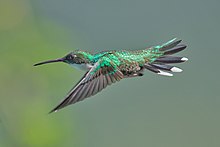White-throated hummingbird
| White-throated hummingbird | |
|---|---|

| |
| Scientific classification | |
| Kingdom: | Animalia |
| Phylum: | Chordata |
| Class: | Aves |
| Order: | Apodiformes |
| Family: | Trochilidae |
| Tribe: | Trochilini |
| Genus: | Leucochloris Reichenbach, 1854 |
| Species: | L. albicollis
|
| Binomial name | |
| Leucochloris albicollis (Vieillot, 1818)
| |

| |
The white-throated hummingbird (Leucochloris albicollis) is a species of hummingbird in the family Trochilidae. It is the only member of the genus Leucochloris. It is found in north-eastern Argentina, south-eastern Brazil, Paraguay, and Uruguay. It is found in forest, woodland, parks and gardens. It is generally common, and therefore considered to be of least concern by BirdLife International.
French ornithologist Louis Jean Pierre Vieillot described the white-throated hummingbird in 1818 as Trochilus albicollis. Its species name is derived from the Latin words albus "white" and collum "neck".[2] Ludwig Reichenbach erected the genus Leucochloris in 1854, deriving the name from the Ancient Greek leukos "white" and chloros "green".
A 2014 genetic study found that it lay within the large genus Amazilia, and that it diverged around 5 million years ago from a lineage that gave rise to the green-and-white hummingbird (Amazilia viridicauda), white-bellied hummingbird (A. chionogaster), rufous-throated sapphire (A. sapphirina), gilded sapphire (Hylocharis chrysura), sapphire-spangled emerald (A. lactea), and glittering-throated emerald (A. fimbriata).[3]

The white-throated hummingbird is 10–11·5 cm (4-4.5 in) long,[4] with a distinctive white throat, belly and tail tips.[5] The head, upperparts, wing coverts, chin and sides of neck are an iridescent green. The rest of the wings are purple-brown.[6] It is unlikely to be confused with any other bird species.[5] The male weighs 5–8 g (0.17–0.28 oz), while the female weighs around 4·5 g (0.16 oz).[4]
The white-throated hummingbird is found in forest margins, marshy areas, shrubland and parks.[4] It forages at both terrestrial and arboreal bromeliads such as Quesnelia testudo and Tillandsia aeranthos, as well as Mendoncia velloziana,[7] and Siphocampylus sulfureus.[8]
References[]
- ^ BirdLife International (2016). "Leucochloris albicollis". IUCN Red List of Threatened Species. 2016: e.T22687479A93153812. doi:10.2305/IUCN.UK.2016-3.RLTS.T22687479A93153812.en. Retrieved 12 November 2021.
- ^ Simpson, D.P. (1979). Cassell's Latin Dictionary (5th ed.). London: Cassell Ltd. pp. 33, 116. ISBN 0-304-52257-0.
- ^ McGuire, Jimmy A; Witt, Christopher C; Remsen, J V; Corl, Ammon; Rabosky, Daniel L; Altshuler, Douglas L; Dudley, Robert (2014). "Molecular phylogenetics and the diversification of hummingbirds". Current Biology. 24 (8): 910–16. doi:10.1016/j.cub.2014.03.016. PMID 24704078.
- ^ a b c Weller, A.A., Kirwan, G.M. & Boesman, P. (2017). White-throated Hummingbird (Leucochloris albicollis). In: del Hoyo, J., Elliott, A., Sargatal, J., Christie, D.A. & de Juana, E. (eds.). Handbook of the Birds of the World Alive. Lynx Edicions, Barcelona. (retrieved from http://www.hbw.com/node/55474 on 19 September 2017).
- ^ a b van Perlo, Ber (2009). A Field Guide to the Birds of Brazil. Oxford University Press. ISBN 9780199745654.
- ^ Hudson, William Henry (5 December 2016). Argentine Ornithology: A Descriptive Catalogue of the Birds of the Argentine Republic, Volume II. Library of Alexandria. p. 23. ISBN 978-1-4655-4745-3.
- ^ Snow, David W.; Teixeira, Dante L. (1982). "Hummingbirds and their flowers in the coastal mountains of southeastern Brazil". Journal für Ornithologie. 123 (4): 446–50. doi:10.1007/BF01643279. S2CID 23568595.
- ^ Sazima, Marlies; Sazima, Ivan; Buzato, Silvana (1994). "Nectar by day and night: Siphocampylus sulfureus (Lobeliaceae) pollinated by hummingbirds and bats". Plant Systematics and Evolution. 191 (3): 237–46. doi:10.1007/bf00984668. S2CID 262033.
- IUCN Red List least concern species
- Trochilinae
- Hummingbird species of South America
- Birds of Argentina
- Birds of Brazil
- Birds of the South Region
- Birds of the Selva Misionera
- Birds of Paraguay
- Birds of Uruguay
- Birds described in 1818
